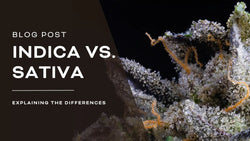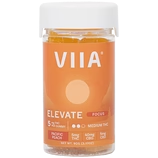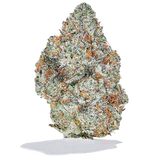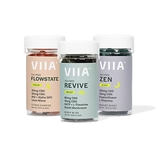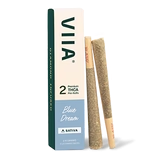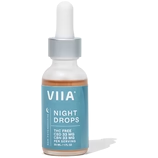 cbd, delta-9
cbd, delta-9CBD Vs. THC: A Comprehensive Comparison

Post Medically Reviewed By
Dr. Denise Foster
CBD is a non-psychoactive compound that offers more subtle effects on the mind and body that many people enjoy for sleep and stress and to support their overall wellness goals.
On the other hand, THC brings its own unique qualities, delivering psychoactive effects alongside potential wellness benefits.
These two primary compounds from the cannabis sativa plant share a common origin but walk decidedly different paths when it comes to their biochemical makeup, the effects they produce, and their legal statuses. Decoding the complexities of CBD vs. THC doesn't require a degree in biochemistry. We've broken it down into bite-sized pieces that anyone can digest.
In this article, we'll unravel these intricacies, highlighting the biochemical differences between CBD and THC, the distinctive experiences you can anticipate, and the legal landscape surrounding their uses.
Overview CBD vs. THC: A Direct Comparison
- Psychoactive Effects: THC induces a psychoactive 'high,' or a feeling of euphoria, while CBD is not impairing and does not cause such an effect.
- Uses: Both CBD and THC have been researched for their potential medical benefits. CBD is known for its potential anti-inflammatory, anti-anxiety, and anti-seizure properties. THC is recognized for its analgesic, ocular pressure-lowering, appetite-stimulating, and sedative effects [1, 2, 3].
- Side Effects: Both cannabinoids can cause side effects. THC side effects can include dry mouth, red eyes, memory loss, anxiety and paranoia, slower reaction times, increased heart rate, and coordination issues. CBD's side effects can include dry mouth, lowered blood pressure, nausea, light-headedness, and drowsiness at higher doses.
- *Legal Status in the U.S.: CBD is federally legal if it's derived from hemp and contains less than 0.3% THC. THC from cannabis, however, is federally illegal but has been legalized for medicinal and/or recreational use in several states. Hemp-derived THC is technically legal federally as long as it complies with the THC legal threshold of 0.3% by dried weight. Some states may have other restrictions on this rule.
- Product Forms and Uses: Both CBD and THC are available in various forms, such as tinctures, gummies, and topicals. CBD is primarily used for wellness purposes, while THC is used recreationally for its psychoactive effects and medicinally in states where it's legal.
- Experiences With THC vs. CBD: THC can induce euphoria, relaxation, and altered sensory perception but may also impair memory and reaction times, provoke anxiety and paranoia, stimulate appetite, and cause dry mouth and red eyes. CBD has much more subtle effects on the mind and body. Its wellness benefits are best observed over time with consistent use.
What are Cannabinoids?
THC and CBD are classified as phytocannabinoids, which are plant-derived compounds that interact with cannabinoid receptors in cells.
These receptors are part of the endocannabinoid system in the body.
Remarkably, our bodies also produce their own cannabinoids, known as endocannabinoids, which interact with this system in similar ways as phytocannabinoids.
The endocannabinoid system is responsible for supporting homeostasis and, maintaining balance across a wide range of physiological processes. These processes include the sleep-wake cycle, immune response, stress, energy metabolism, and neurotransmitter release in the brain. Think of the endocannabinoid system as your body’s radio dial; unless your body is ‘tuned’ into the right frequency, your homeostatic balance is off, and you have ‘static’ above and below your frequency. Your body’s own endocannabinoids help to tune your body’s frequency to maintain an individual wellness that’s just right for you.
The interplay between cannabis-derived phytocannabinoids and endocannabinoids within this system is an interesting and expanding field of research for scientists and healthcare practitioners. The more they discover, the better we understand how cannabis and hemp-derived products could play a part in supporting healthy, holistic lifestyles.
THC: The Psychoactive Cannabinoid
Tetrahydrocannabinol, better known as THC, is one of the main cannabinoids found in cannabis plants, infamous for its psychoactive effects.
While there are many isomers (variations) of the THC molecule — like delta-8 and delta-10— delta-9 THC is the most abundant and what's commonly referenced when referring to the psychoactive effects associated with cannabis.
The unique shape of cannabinoids gives them distinct effects on the body.
The THC molecule center has a flat, circular shape formed by two connected rings (carbon ring and cyclopropane ring). Imagine these as the body of a spider. This is the main chemical structure of all THC isomers, its primary base of two connected rings.
Hanging off this "spider body," there are a few "legs," which are chains of atoms (carbon chains). This unique shape allows THC to bind tightly with CB1 receptors in our brains, triggering its famous mind-altering and euphoric effects.
Now, we did mention that there are many other forms of THC.
The existence of different isomers or forms of THC (like delta-8 and delta-10 mentioned above) has to do with the unique flexibility of the carbon atoms in the THC molecule.
In chemistry, an isomer refers to one of two or more compounds that have the same chemical formula but possess differing arrangements of atoms off the base molecule and different properties. For THC, the isomers vary based on the position of a double bond in the molecule's carbon chain.
Delta-8 Tetrahydrocannabinol
Delta-8 THC is a variant of THC that is less common than its delta-9 counterpart.
It has a structure similar to delta-9 THC but with slight differences that affect its potency.
Despite its lower concentration in the cannabis plant, delta-8 THC products still provoke psychoactive effects, although they're often described as less intense and more clear-headed than those of delta-9 THC. Think of delta-8 THC as drinking a glass of wine when used in moderation.
Delta-10 Tetrahydrocannabinol
Like other forms of THC, delta-10 THC interacts with the body's endocannabinoid system, but the difference in the molecular structure means it doesn't bind as efficiently to the cannabinoid receptors, particularly the CB1 receptors in the brain that are responsible for the psychoactive effects of cannabis.
Some users have reported that the delta-10 THC high provides a more clear-headed and energetic feeling compared to the relaxing and calming effects of delta-8 and the more potent psychoactive effects of delta-9. Delta-10 THC should not be used for sleep unless you want to stay up all night!
Effects of Tetrahydrocannabinol (THC)
THC, or tetrahydrocannabinol, boasts a unique natural chemical structure that fits like a key into the lock of the body's CB1 receptors, mainly in our brain and nervous system.
This interaction between the THC molecule and the body’s CB1 receptor stimulates the release or the inhibition of neurotransmitters—chemical messengers transmitting signals throughout the body—influencing various physiological and psychological activities.
Now, what does this really mean for you?
Well, this process translates into various effects on your mood, sensory perception, appetite, and more. With the right doses, it's common for people to experience a sense of euphoria, changes in thought, perception, and time, memory impairment, and even an increased appetite—a phenomenon lovingly dubbed "the munchies."
While THC's mind-altering capabilities make it a popular choice for recreational purposes, it's not all about the 'high.' THC is much more than its psychoactive properties—it's also a potential therapeutic powerhouse.
You see, researchers have been intrigued by the possible medicinal benefits of THC for decades.
Medical marijuana programs frequently employ cannabis strains that have higher concentrations of THC to support various health issues. For instance, THC's potential analgesic (pain-relieving) actions make it a popular choice for managing chronic pain in conditions like fibromyalgia and multiple sclerosis in clinical studies [4, 5]. THC has also been effective in cancer and in managing the nausea and vomiting typically associated with chemotherapy treatment [3].
Potential Risks of Using THC
While THC can offer certain health benefits, it's not without its potential side effects.
THC use can cause temporary impairments in short-term memory, coordination, and judgment, along with increased heart rate and anxiety. Hence, responsible usage when consuming THC is crucial. One of the most important mantras of cannabis as medicine is to start low — less is more! This phenomenon of dosing at minimal levels is called microdosing, and when you use THC at the microdose level, you can better control the effects you want out of the molecule without generating intoxicating effects. Current research even suggests that microdosing THC has a neuroprotective effect, and this is an area of study that has excited scientists as they examine the numerous health benefits related to THC use [17].
Legal Status of THC
The legal status of THC in the United States is complex and varies from state to state due to a mix of federal and state laws.
In the eyes of federal law, marijuana (Cannabis sativa plants with more than 0.3% THC by dried weight) and its derivatives (including THC products) are classified as Schedule I controlled substances under the Controlled Substances Act.
This means that, federally, marijuana is illegal to manufacture, distribute, or possess. However, the enforcement of these laws has evolved over time. On August 29, 2023, the Department of Health and Human Services (HHS) recommended to the Drug Enforcement Administration (DEA) that marijuana be rescheduled from Schedule I to Schedule III under the Controlled Substances Act (CSA).
Also, in recent years, some significant changes have affected the legality of certain cannabis and hemp products.
One notable event was the passage of the 2018 Farm Bill, which legalized the production of hemp (cannabis plants that contain less than 0.3% Delta-9 THC by dry weight).
This legislation has been interpreted to allow the production and sale of certain hemp-derived products, including some forms of delta-8 THC and CBD. However, the interpretation and enforcement of this law can vary.
On the state level, the picture is even more complex.
A growing number of states have passed laws legalizing marijuana, either for medical and/or adult use, despite federal prohibition.
If you're considering using THC or any cannabis product, we encourage you to research the laws in your specific area. When in doubt, consulting with a legal professional can clarify the most up-to-date regulations.
Lastly, keep in mind that even in states where marijuana is legal, there can still be restrictions on where it can be consumed, how much you can possess, and other aspects of its use.
CBD: The Calming Cannabinoid without the High
CBD, or cannabidiol, is the second most famous compound after THC in the cannabis plant.
Unlike THC, CBD is non-psychoactive, meaning that it doesn't cause the "high" typically associated with cannabis.
This unique quality has contributed to its growing popularity in the wellness space for those looking to explore the health benefits of cannabis without the mind-altering consequences.
CBD can be found in both hemp and marijuana plants, most CBD products are hemp-derived due to hemp having higher CBD concentrations and are within the federally legal THC threshold of (0.3%).
Effects of CBD Products
CBD also interacts with the body's endocannabinoid system, but differently from THC.
It's found to have a low affinity to bind to CB1 and CB2 receptors, instead influencing them indirectly and enhancing levels of endocannabinoids produced by the body.
Some studies have found CBD to interact with non-cannabinoid receptors involved in pain perception and inflammation [6].
CBD's effects are subtler than those of THC products. You won't get a rush of euphoria, but you might notice an overall calmer mood and may feel well-rested over time.
CBD has been central to medical cannabis research for its potential anti-inflammatory, anti-anxiety, anti-seizure, and analgesic properties. It's currently used to manage conditions like epilepsy (with the FDA-approved Epidiolex), chronic pain, and anxiety disorders [7, 8, 9].
CBD Use: Potential Risks & Side Effects
CBD has a favorable safety profile, which means it's been found to be safe and well-tolerated in most individuals. Despite this, CBD products aren't completely without side effects.
Some side effects of CBD include dry mouth, lowered blood pressure, light-headedness, stomach upset, and drowsiness, particularly in higher doses.
On a regulatory level, because the CBD industry is so new and the FDA is still figuring out how to regulate it, not all hemp-derived CBD products are of high quality.
This is why it's important for consumers to research and purchase products from reputable brands that can provide third-party lab tests to verify the cannabis potency and safety profile of their products.
Role of CBD and THC in Hemp-Derived Products
The concentrations of CBD and THC have key roles in hemp-derived products, and understanding their effects and the entourage effect is important.
Plus, different CBD-to-THC ratios can influence how these products work.
So, let's dive in and talk about how to read product labels like a pro.
You might have heard about the entourage effect, right?
It's when all the different compounds in the cannabis plant, like cannabinoids and terpenes, work together to enhance each other's effects. CBD and THC are the star players in this synergy, adding their own unique contributions to the mix.
But here's the catch: this magical synergy is typically found in full-spectrum hemp products, not in isolate CBD or THC.
Full-spectrum means that the product contains not only CBD and THC but also a range of other beneficial compounds naturally present in the plant, such as minor cannabinoids (CBG, CBN, etc.) and aromatic terpenes.
Why is this important?
These additional compounds in full-spectrum products work harmoniously with CBD and THC, enhancing their effects and potentially unlocking well-balanced and robust effects.
When it comes to reading product labels, it's all about being an informed consumer. Check out these important tips:
- Look for the specific CBD and THC amounts on the label. This helps you understand the relative proportions and potential effects of each compound.
- Find out if the product is full-spectrum (CBD, THC, and other cannabinoids), broad-spectrum (CBD and other cannabinoids without THC), or CBD isolate (pure CBD). Knowing this helps you gauge the entourage effect and potential benefits.
- Only use products with third-party lab testing results. These tests ensure that the CBD and THC content is accurate and the product meets quality and safety standards.
- Consider the origin and manufacturing practices. Opt for products made from organically grown hemp and manufactured by reputable companies.
Final Thoughts: CBD vs. THC
To wrap it up, gaining a solid understanding of CBD and THC is crucial when considering hemp-derived cannabinoid products.
CBD steps up as a non-psychoactive superstar, offering more subtle effects on the mind and body that many people enjoy for sleep and stress and to support their overall wellness goals.
On the other hand, THC brings its own unique qualities, delivering psychoactive effects alongside potential wellness benefits.
By delving into the biochemical differences, effects on the body and mind, potential risks, and legal status, you can become a more informed decision-maker regarding your cannabis use.
Remember, it's not just about CBD and THC on their own. It's also about the incredible teamwork they exhibit in the entourage effect. When these cannabinoids collaborate with other compounds found in the cannabis plant, like terpenes, magic happens. They amplify each other's effects, creating a more harmonious experience with your cannabis products.
Frequently Asked Questions
Resources:
- Burstein, S. (2015). Cannabidiol (CBD) and its analogs: a review of their effects on inflammation. Bioorganic & medicinal chemistry, 23(7), 1377-1385.
- Überall, M. A. (2020). A review of scientific evidence for THC: CBD oromucosal spray (nabiximols) in the management of chronic pain. Journal of pain research, 399-410.
- Thapa, D., Cairns, E. A., Szczesniak, A. M., Toguri, J. T., Caldwell, M. D., & Kelly, M. E. (2018). The cannabinoids Δ8THC, CBD, and HU-308 act via distinct receptors to reduce corneal pain and inflammation. Cannabis and cannabinoid research, 3(1), 11-20.
- Chaves, C., Bittencourt, P. C. T., & Pelegrini, A. (2020). Ingestion of a THC-rich cannabis oil in people with fibromyalgia: a randomized, double-blind, placebo-controlled clinical trial. Pain Medicine, 21(10), 2212-2218.
- Ungerleider, J. T., Andyrsiak, T., Fairbanks, L., Ellison, G. W., & Myers, L. W. (1988). Delta-9-THC in the treatment of spasticity associated with multiple sclerosis. Advances in alcohol & substance abuse, 7(1), 39-50.
- Eskander, J. P., Spall, J., Spall, A., Shah, R. V., & Kaye, A. D. (2020). Cannabidiol (CBD) as a treatment of acute and chronic back pain: A case series and literature review. J Opioid Manag, 16(3), 215-8.
- Gray, R. A., & Whalley, B. J. (2020). The proposed mechanisms of action of CBD in epilepsy. Epileptic Disorders, 22, S10-S15.
- Boyaji, S., Merkow, J., Elman, R. N. M., Kaye, A. D., Yong, R. J., & Urman, R. D. (2020). The role of cannabidiol (CBD) in chronic pain management: an assessment of current evidence. Current pain and headache reports, 24, 1-6.
- Blessing, E. M., Steenkamp, M. M., Manzanares, J., & Marmar, C. R. (2015). Cannabidiol as a potential treatment for anxiety disorders. Neurotherapeutics, 12(4), 825-836.
- Preet, A., Ganju, R. K., & Groopman, J. E. (2008). Δ9-Tetrahydrocannabinol inhibits epithelial growth factor-induced lung cancer cell migration in vitro as well as its growth and metastasis in vivo. Oncogene, 27(3), 339-346.
- Musty, R. E., & Rossi, R. (2001). Effects of smoked cannabis and oral Δ9-tetrahydrocannabinol on nausea and emesis after cancer chemotherapy: a review of state clinical trials. Journal of Cannabis Therapeutics, 1(1), 29-56.
- Shapira, G., Israel-Elgali, I., Grad, M., Avnat, E., Rachmany, L., Sarne, Y., & Shomron, N. (2023). Hippocampal differential expression underlying the neuroprotective effect of delta-9-tetrahydrocannabinol microdose on old mice. Frontiers in Neuroscience, 17.
- National Conference of State Legislatures. (2023). Cannabis Overview. Retrieved from https://www.ncsl.org/civil-and-criminal-justice/cannabis-overview.
